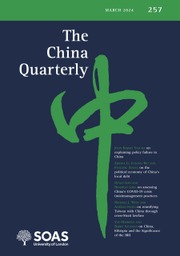Article contents
Contingent Attachment: Long-term Lived Experience in the Redevelopment of a Third Front Neighbourhood
Published online by Cambridge University Press: 28 October 2024
Abstract
Employing the concept of “contingent attachment” as its key point, this paper investigates the transformation of residents’ neighbourhood attachment during the redevelopment of a neighbourhood originally established during the Third Front construction period. By framing neighbourhood attachment as contingent, this paper seeks to highlight that the different directions of neighbourhood attachment hinge upon several factors: the entities mobilizing the narrative, the varying treatment of residents across different phases of the relocation, and residents’ perceptions regarding the changes brought about by the relocation process. Special attention within this paper is paid towards the long-term lived experiences of residents since the onset of the Third Front construction to show how these experiences are woven into diverse narratives associated with residents’ neighbourhood attachments.
摘要
本文以“依条件而变的依恋”这一概念作为核心点,研究了一个奠基于“三线建设”时期的社区在改造过程中居民邻里依恋的转型。通过为邻里依恋提供一个依条件而变的框架,本文力图展现邻里依恋的不同指向取决于多个因素:调用依恋叙事的实体、居民在被安置的不同阶段所受到的不同待遇,以及居民对安置过程所带来的变化的感知。本文尤其关注居民从三线建设开始以来的长期居住经历,并且将呈现这些体验是如何被编织进与居民的邻里依恋相关的多样叙事之中。
Keywords
Information
- Type
- Research Article
- Information
- Copyright
- Copyright © The Author(s), 2024. Published by Cambridge University Press on behalf of SOAS University of London
References
- 1
- Cited by


